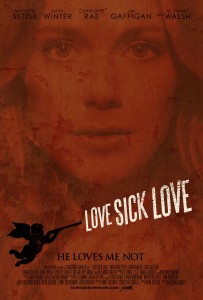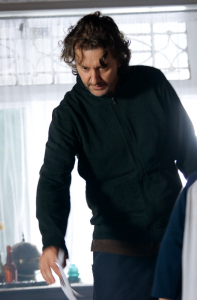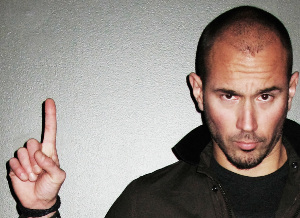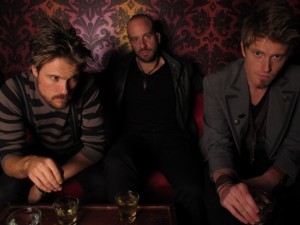Film Soundtrack Spotlight: Music Supervising "Love Sick Love" — From Score to Synch
Love and obsession – it’s a match made in cinematic heaven.
The latest film to go there, and then go deeper, is Love Sick Love, a new indie film released by the NYC-based mouseROAR. Directed by Christian Charles (Cheech & Chong’s Hey Watch This), the movie is a deft combination of suspense, comedy, and romance (or it’s evil twin, rather).
The feature-length tale follows power-couple Dori and Norman as their weekend trip to the countryside completely unravels, spurred on by her psychopathic tendencies. Throughout the film, music plays a key role, constantly helping to set the scene and keep the viewer oriented – the result of a sharp collaboration between Charles, music supervisor and SongHunters co-founder Dave Hnatiuk (Heights, Cheech and Chong’s Hey Watch This), and John Swihart (Napoleon Dynamite, Youth In Revolt, Employee of the Month).
Making the original music and soundtrack gel on a movie – whether it’s an indie film or Hollywood release – is always a complex task for the music supervisor, who wants to ensure that the sonic component fully supports the director’s vision. SonicScoop took the opportunity to get the perspective of both Charles and Hnatiuk on their work together throughout many of the music supervision phases of Love Sick Love.
For an in-depth look at the interplay between director and music supervisor on a film soundtrack that was equally rewarding and challenging to pull together, keep reading.
The Love Sick Love full-length trailer:
Meeting of the Minds
Before a music supervisor and director dive into a feature film together, there’s no substitute for trust and the chemistry that comes with it. Hnatiuk became involved with Love Sick Love after working on a film with Charles and mouseROAR in 2003, the New Line Cinema-distributed Full of It starring Ryan Pinkston and Terri Pollo.
“Christian and I met by being introduced by a mutual friend who worked on the advertising campaign for Christian’s first feature Comedian, starring Jerry Seinfeld,” Hnatiuk recalls. “Around this time Love Sick Love was in the early stages of script development, and Christian handed me the script to kind of put it on my radar as something I should read, with the notion that we may one day be making this film together. Well, about five or more years later, we made it, and here we are!”
Meanwhile, Charles had developed a clear director’s perspective on music’s importance in a movie’s storytelling. “It’s emotional support,” he says. “It sometimes can define a specific emotion that isn’t clear with picture alone. It’s also the biggest cheat as far as getting your audience emotionally invested in a scene – that’s what Dave is so good at delivering and why we collaborate so much.
“I love music that has bold expression,” he continues, “that unashamedly makes its emotional or lyrical point. No time to beat around the bush when you’re telling a tight story.”
Besides knowing what he wants in his music, Charles knows what he needs in a music supervisor. “Breadth of musical knowledge,” he states. “Unending delivery of material when you’re searching for a specific song to fit the bill. Great negotiating skills. Great taste and passion for music. This is one of the more fun parts of making a film — it should work that way with a music supervisor. Dave has all these qualities and a whole lot more.”
Setting the Musical Direction for Love Sick Love
Once his collaboration with Charles on Love Sick Love was established, Hnatiuk began laying the groundwork for pairing each scene with the right music.
“I started reading early versions of the script years before we actually made the film, and this gave Christian and I plenty of time to play with and brainstorm on a variety of musical directions that Love Sick Love could take,” says Hnatiuk. “The process starts with the ‘blocking/spotting’ process of breaking down the script and deciding simply where music will be and where it won’t.
“Once, the blocking/spotting is done, we then look at each cue/spot and play with ideas on whether each spot we deemed music-worthy should be original score, or commercially licensed music.”
After some back and forth on what the music direction would ultimately become, Hnatiuk and Charles landed on the fairly traditional approach of original score, by John Swihart. Complementing it would be a carefully curated selection of modern multi-genre indie pop and rock, singer/songwriter ballads, and pop vocal classics circa the 1950’s.
“The film is multiple genres, deliberately,” Charles says. “The musical tone was tricky. We ultimately found our way in by using the voice of Dori. The majority of the music comes from a female perspective, although there are pieces in there that are pure nostalgia to set a tone in the isolated old house.”
To Hnatiuk, obtaining synch licenses for the Love Sick Love soundtrack was an ideal opportunity to match up emerging artists with classic tracks. “This ended up being a multi-genre, multi-time period, pop and indie rock direction chock full of incredibly talented and on-the-rise indie artists that many viewers probably have not heard of before, but will be excited to experience for the first time,” he says.
“Those indie artists that will be new discoveries for many viewers are consciously complemented throughout the film by well-known and forgotten classics from the 1950’s vocal pop era, such as Jackie Wilson’s ‘My Heart Belongs Only to You’ which we were able to license from our good friend Jamar Chess of Sunflower Entertainment, as well as a number of other classics that for our younger viewers may be a first-time experience which will broaden their musical horizons. For our more mature viewers, it will be a nice nostalgic reminder of how the old and new can meet in a musically timeless way.”
Deciding When to Use Original Music vs. Synch Licensed Tracks in a Scene
With their extended pre-production period, Hnatiuk and Charles were afforded ample time to start the decision making process on which scenes would call for score, and which would call for commercial music that would require synch licensing to clear.
“One of the simplest ways to determine the possibility of using score or commercial music could be determined by the physical setting or environment of any given scene,” Hnatiuk explains. “Source music cues are one of the easiest places to feature commercial songs. If a song is playing from a bedroom clock radio, a car stereo, a jukebox at a bar, or at a club/restaurant, all of these type of scenes allow for the opportunity to place a commercial pop/rock song.
“And we took advantage of plenty of source opportunities in LSL,” he adds. “Anytime you have a human scenario in a relatable scene where viewers are used to hearing source music –which means you have a song in a scene being played from a realistically believable physical source/location – you have the opportunity to try using a piece of commercial music. Then it becomes the question of what kind of song would or should be playing in this scene which can be determined by any number of character traits, storyline, geographical influences, time-period, and more.”
According to Hnatiuk, scenes will call for original custom designed music when the director is looking to establish a very particular emotional backdrop, that cannot be accurately focused upon by using a piece of commercial music. “Our main title sequence is composed score,” he says. “We have some action sequences that are driven by score, and we have some other various dramatic scenes that called for score as well.”
When and Why to Commission a Cover Song
One scene in particular in Love Sick Love presented a tricky challenge. For director Christian Charles, only the classic New Year’s Eve standby “Auld Lang Syne” would do
However, it soon became clear to Hnatiuk that there wasn’t a version of the song that was both ideal for the visual, and also affordable to license. “We searched for covers of ‘Auld Lange Syne’ tirelessly,” Hnatiuk notes, “in hopes to find a version that we could both afford to license and that supported the pacing of our sequence as well as the tonal feel / emotional backdrop – two critical elements that cannot be sacrificed in any scene of a film, let alone such a climactic scene as this cover was used.
“Our search led us to a handful of versions that we liked all of which we tried to use, but each ended up being flawed in some way. That said, we decided to take the inspiration from the parts of each version we liked, as well as significant additional production notes that led us to the beautiful cover of ‘Auld Lange Syne’ that lives in Love Sick Love forever.”
As you may have guessed, the solution for the fruitless search was to record an updated edition. The result was a collaboration with the Australian duo The Kin, who tailor made “Auld Lang Syne” for Love Sick Love.
“There were a couple reasons to make a new cover version of the song,” says Hnatiuk. “First off, the pacing of the scene was of the utmost importance, and there were variations in character motivation/scene development/ physical movements that needed to be taken in consideration when producing this cover.
“In that sense, we treated this cover almost identically to how score is developed — this is precisely why our score composer John Swihart co-produced this track with Christian Charles and I. John’s song arranging skills were imperative in helping us produce this song, and seamlessly support the pace of one of the most important scenes in the film.”
To make the new song, the recording process was done remotely and file transfers occurred via FTP, allowing for a short demo phase that eventually lead to locking down and finishing the track as the video cut of the sequence it was in came closer and closer to final. Engineer/producer Nic Hard tracked the vocals in NYC, with the Kin’s Isaac and Thorald Koren performing the vocals, and Thorald also playing guitar. Swihart co-produced, arranged, and mixed the song, as well as playing additional guitars out of his LA studio.
It was extra work, but worth it: Charles got the exact musical mood he was looking for, and added to the film’s impact in the process. “I’m excited for the world to hear it,” Hnatiuk says. “It’s definitely memorable, and hits home in the way this song was intended to.”
Learning From Experience
Just as every film is a unique viewing experience, each project also presents a different music supervision path for all involved. For Charles, the development of Cheech & Chong’s comeback concert film, Hey Watch This, (released in 2011 by Weinstein Company) proved completely distinct from scoring and synching Love Sick Love.
“Cheech & Chong was so much about what the duo had done before,” Charles observes. “Both score and needle drop were inspired by their original musical vibe — hard to ignore and probably foolish to ignore too. Love Sick Love is purely it’s own thing, and required so many subtle decisions to make sure the multi-genre feeling was successfully accomplished. Harder work but ultimately way more satisfying.
“The accomplishment of making the multi genre idea work was ambitious, and the reason I wanted to make the film in the first place,” continues Charles. “I would also say that we managed to create a really rich and confident soundtrack with an incredibly limited budget. This is a real sleight of hand and I’d like to think we pulled it off very effectively.”
For a music supervisor like Dave Hnatiuk, wrapping up a feature, with every cue composed, cleared, fully licensed and locked to picture, qualifies as a high.
“The feeling of seeing the final film finished on the big screen with a final mix, especially after having worked on it for literally years is extremely positive — the sense of accomplishment is like no other feeling,” says Hnatiuk. “The artistic achievement to complete a feature length film within your budget, on time/deadline, and within the framework of your artistic/musical strategy, is one of the best payoffs I’ve ever felt. When a feature length film is completed, there is a great feeling of camaraderie in the team effort that was achieved. It’s truly priceless.”
– David Weiss is the Founder/Editor of SonicScoop, and co-author of the book Music Supervision: Selecting Music for Movies, TV, Games & New Media.










